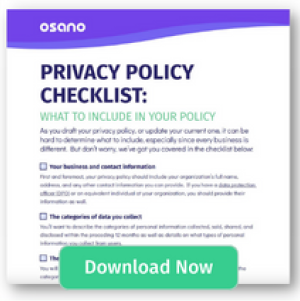
How to Shift Data Privacy Left
The 1:10:100 rule—coined in 1992 by George Labovitz and Yu Sang...
Read NowGet an overview of the simple, all-in-one data privacy platform
Manage consent for data privacy laws in 50+ countries
Streamline and automate the DSAR workflow
Efficiently manage assessment workflows using custom or pre-built templates
Streamline consent, utilize non-cookie data, and enhance customer trust
Automate and visualize data store discovery and classification
Ensure your customers’ data is in good hands
Key Features & Integrations
Discover how Osano supports CPRA compliance
Learn about the CCPA and how Osano can help
Achieve compliance with one of the world’s most comprehensive data privacy laws
Key resources on all things data privacy
Expert insights on all things privacy
Key resources to further your data privacy education
Meet some of the 5,000+ leaders using Osano to transform their privacy programs
A guide to data privacy in the U.S.
What's the latest from Osano?
Data privacy is complex but you're not alone
Join our weekly newsletter with over 35,000 subscribers
Global experts share insights and compelling personal stories about the critical importance of data privacy
Osano CEO, Arlo Gilbert, covers the history of data privacy and how companies can start a privacy program
Upcoming webinars and in-person events designed for privacy professionals
The Osano story
Become an Osanian and help us build the future of privacy!
We’re eager to hear from you
Interested in partnering with us?
Increase Trust. Stay Compliant. Get Cool Swag.
Inquiries and Osano in the news
Add Osano data privacy ratings and recommendations to your application
.webp?width=1220&height=1090&name=Osano-guarantee-seal%20(1).webp)
Updated: April 11, 2023
Published: November 10, 2021

IPL (China’s privacy law) is in force: Here's what you need to know about the law and how you should start thinking about compliance.
On Nov. 1, the brand-new Personal Information Protection Law (PIPL) came into force in the People’s Republic of China. It is a comprehensive, modern, globally consistent law on par with the EU’s General Data Protection Regulation, and it is imperative that you understand it if you’re collecting the personal information of people residing within China’s borders.
How comprehensive is it? Both LinkedIn (which Microsoft owns) and Yahoo have decided compliance is not worth the cost of doing business at this point. They pulled out of China as the law went into effect last week.
The law is not, however, particularly difficult to understand, nor is it overly complex. The translation by the folks at Stanford isn’t even 6,000 words, and many of the provisions should already be part of any decent privacy program that’s complying with the EU General Data Protection Regulation (GDPR) or the California Consumer Privacy Act (CCPA).
In fact, most of the initial portion of the PIPL asserts that organizations should follow basic privacy principles that go back to the 1970s:
If you’re doing all of that, you should be good! It sounds simplistic, but PIPL, like many privacy laws over the last decade, really does basically adhere to the good old “surprise minimization” principle: Would someone be surprised to discover you were doing that with their data? Then don’t do it.
And PIPL gives you good reason to follow that principle: Minor violations can result in the Chinese government seeking to recoup the money you made by violating PIPL. It may halt your operations entirely within China. In addition, major violations can result in a fine of up to 5% of your annual revenue, or $7.5 million or so, whichever is higher. And there can be fines for individuals of up to about $150k. Plus, you may have to compensate affected parties. People can sue you directly and can sue individuals directly for violations of the act.
As the law is still brand-new, there are still a few areas where Chinese regulators still need to fill in details. Especially important will be amounts of data that trigger certain elevated requirements for sending data outside the country, for example, and certain security measures be put in place. More news will be coming out of China over the course of the next six months to a year, for sure. Of course, additional regulations and guidelines are forthcoming.
That’s the sort of situation that catches your attention, hopefully, if you’re doing business in China. There are some nuances worth paying attention to, even if you’re following the basic principles outlined above.
The methods of transfer outside of China are still a bit in flux. As it reads now, you need to have explicit consent from the data subject and be able to satisfy one of the following:
If you handle a certain amount of data — to be determined — you will also have to satisfy the Chinese cybersecurity and information department that you have appropriate security in place.
For the time being, if you’re moving personal data from China to not-China, you should make sure that it’s secure, that you have a contract of some kind in place that gives you assurances about adequate security if you’re working with a third party, and that you have explicit consent gathered in a way that explains where the data is going and who will have possession of it.
Also: the law explicitly prohibits providing personal information to any foreign government entity (like law enforcement) without permission from the Chinese government.
You’ll need to get sophisticated with your means of gathering consent. Not only does it need to be explicit, but it also needs to be specific. If you’re changing your handling of the data, if you’re passing the data onward or if the data is involved in any kind of automated decision-making, you’re going to need to get new consent for that.
Make sure your meta-tagging involves specific reference to what exact consent is attached to each piece of personal data.
Oh, and the age of consent is 14. Before that, you need parental or guardian consent.
If you’re sharing data with anyone, even inside China, not only do you have to get consent for that, but you also need to have a contract with that third party outlining exactly what they’re allowed to do with the data. Nor can they ever share that with yet another third party, even if they contract. You have to set up an independent contract for that onward transfer.
Sharing data with a third-party outside of China? See above on data transfers and data localization.
If you’re doing any automated decision making, you not only need explicit consent, but that consent needs to be based on a transparent explanation of how the decision making is done, and you have to guarantee “the fairness and justice” of the results.
If it creates a biased result, where some people get a better deal based on providing their personal information, that’s not allowed.
In general, the data subject rights are similar to those already in place for the GDPR and CCPA. People have a right to see what data you have, to be provided a copy, and to be able to easily take that data to another organization. They have a right to deletion and correction, as well, though, you’ll remember, you’re supposed to delete their data anyway when you’re done using it for the specific purpose you collected it.
Finally, it has to be “convenient” for people to exercise these rights.
The law is fairly specific about how you have to handle personal data in terms of your internal operations. You have to have an internal policy that you can demonstrate to regulators and the public, and if you handle a certain amount of data (to be determined), you have to have a specific “personal information protection officer.”
It’s unclear whether you can outsource that position, but that person definitely has to be easy to find.
Also, if you don’t have a mainland presence in China, you have to have an on-the-ground representative who people and the government can contact.
Finally, as part of your personal information protection program, you have to “regularly” audit yourself to make sure you’re doing what you’re saying you’re doing, and you have to perform personal information impact assessments any time there’s a chance you’re handling sensitive information, doing automated decision making, sending data outside the mainland or providing it to a third party. That PIIA has to determine the legality of what you’re about to do and what the impact on the individuals would be in terms of their rights, interests, and the likelihood of their data being protected in the future
If you don’t follow any of the above requirements, the penalties begin to enter the realm of possibility. There are also special requirements for “personal information handlers providing important Internet platform services, that have a large number of users, and whose business models are complex” — including a requirement that you create a fully independent body to oversee your data handling — but we’ll assume that if you’re one of those kinds of companies you have a team of lawyers already working on this and you’re not getting your guidance on this from us.
For most organizations operating in China, the safest course is radical transparency. Gather only what you need, tell people exactly what you’re going to do with it, and don’t do anything without getting consent to do it. Oh, and make sure no one gains unauthorized access and the data stays in China.
That should keep you below the radar for the time being.
Are you in the process of refreshing your current privacy policy or building a whole new one? Are you scratching your head over what to include? Use this interactive checklist to guide you.
Download Now
Sam is a journalist and head of West Gray Creative, a content services firm based in Maine. In a former life, he was director of content at the IAPP and has run publications in the security, workboat, and 3D reality capture spaces. Currently, he serves as the chair of his local school board, fronts the World Famous Grassholes, and would like to be a professional baseball player when he grows up.
Osano is used by the world's most innovative and forward-thinking companies to easily manage and monitor their privacy compliance.
With Osano, building, managing, and scaling your privacy program becomes simple. Schedule a demo or try a free 30-day trial today.